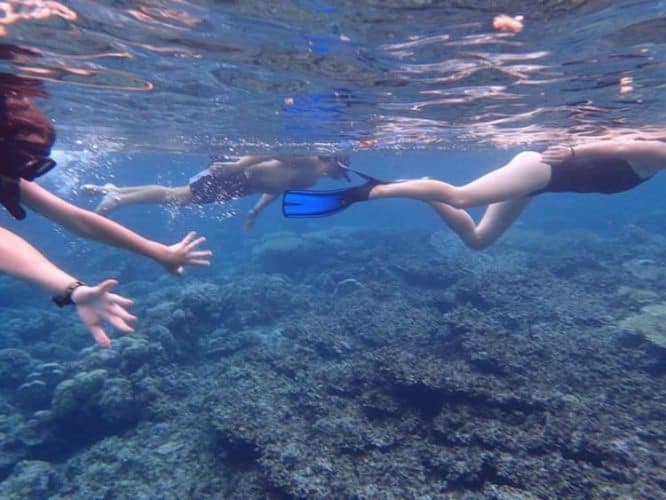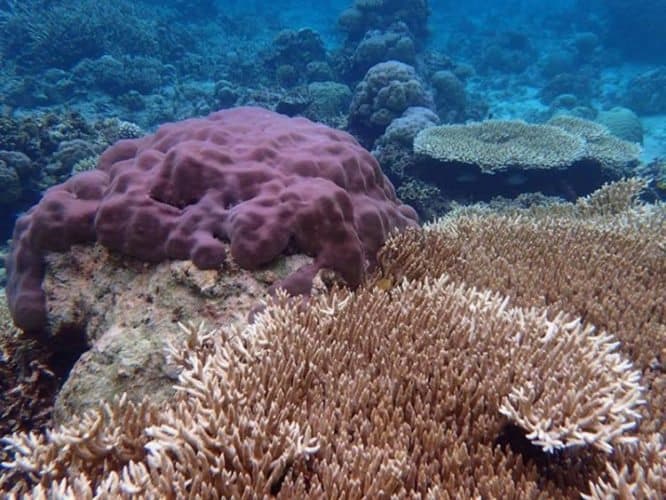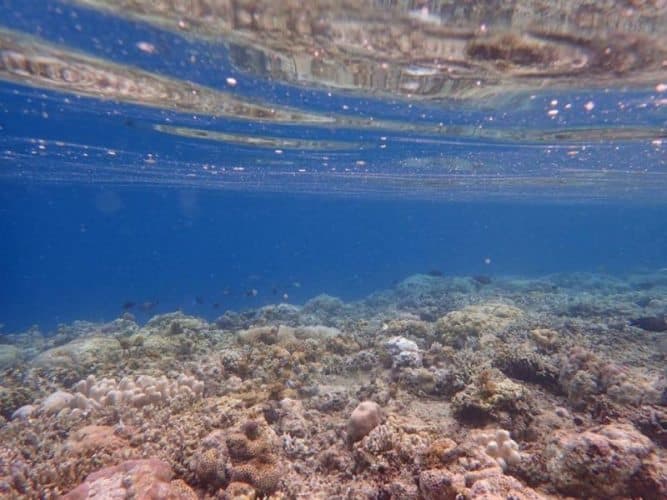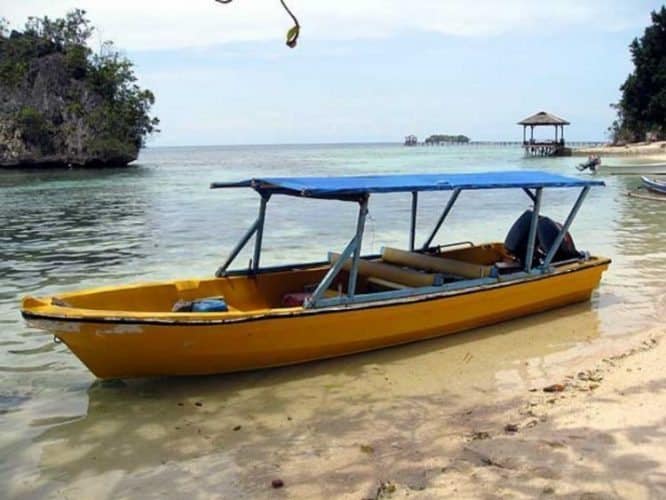
Indonesia: Bombed and Bleached Coral Reefs
Local is working to save the coral reefs of the Togean Islands
By Fuyah
I found myself swimming through a grey and deserted battlefield, littered with the lost lives of its coral comrades, fish swimming around in circles, aimlessly about like demented citizens in a ghost town.
Silently drifting and surviving off of the scraps left behind. Homeless and abandoned, living out the rest of their prison sentenced lives here within the waters, surrounded by the grey death-rubble of their former homes.
Piles of dead coral lined the ground, hundreds of years of evolution wiped out in one swift blow. The others who took the journey with us that morning to Una Una Island in the Togeans were diving below; I was snorkeling one the surface, speechless and bewildered by the massacre.
Coral Decline

The Togean Islands, located in Central Sulawesi Indonesia, have been a tourist destination for decades. Ali, one of the instructors here at Black Marlin Resort on Kadidiri Island is a local who grew up on Una Una, our destination for the day. Una Una is a volcanic island that was quite prosperous before it erupted on the 23rd of July, 1982, when Ali was 5 years old. When the volcano erupted, it destroyed much of what his family had, dislocating him to Wakai, one of the larger Togean islands closer to the mainland, for the years of his youth.
For the past 20 year, since turning 17, Ali has worked as a tour guide and for the past 10 years he has been located at Black Marlin resort where he brings people out diving. He is the only person from the Togean islands mentioned in the Lonely Planet and is also quite infamous in his area for the work he has done to protect the reefs that he has been visiting since he was a child.
Ali has been working in an attempt to unify the police, the local fishermen, the resorts and the reef and is hated for his activism by the locals who are using the wealth of the oceans to feed their families. Ali says that they are not to be pitied though; greed is the driving factor in the bombing and destruction of these ecosystems that are becoming more and more endangered.
Dynamiting the Reefs
He tells us how it all began in 1997 when the first dynamite blasts began. The local fishermen were seeking out yellow tail forsier that travelled in big groups. These fish sold for good money and were the key to quick and temporary wealth. Once the dynamite blasts were complete, it is easy to catch the fish with a net. The dynamite blasts occurred by day and single-handedly wiped out hundreds of years of evolution in a swift blow.
Cyanide poisoning is the second favorite method used by the locals and is even more dangerous than bombing. Cyanide poisoning began in 1998 and is used primarily in search of Barramundi and Gropers.
Locals will come by night, equipped with long tubes and cyanide. They dive down deep, use the long tubes to breathe and drop the cyanide down which causes for the fish to get dizzy and float to the top. They then catch the fish with a net and make their escape. The locals about know nothing about the dangers of the waters such as nitrogen poisoning and other problems that come with increased pressure and often times stay under the water for far too long.
“Some people say that this is the only way to survive my life, by bombing and destroying the reef for one payday; bullshit! This is bullshit, and I’m the enemy now. I’m the enemy for saying something!”

And the coral not being bombed? What has not been destroyed by the destructive fishing of the locals is slowly losing its color and life due to coral bleaching.
Coral bleaching is thought to be caused by the increase in water temperatures as well as ocean acidification. Ali tells us that in the past five years, sea temperatures have risen from 25-26C to 30-31. This temperature increase has caused massive amounts of population declines within the fish as well as a large amount of bleaching within the coral.
At this point, it is difficult to imagine a solution that would save the reefs in the Togean.
Simply put, coral bleaching occurs due to the overheating of coral. Coral ecosystems operate very close to their maximum temperature threshold and even temperature increases of 1 degree Celsius can have dramatic impact upon the coral ecosystem. The National Oceanic and Atmospheric Administration (NOAA) says the 95 percent of all U.S. coral reefs are expected to see ocean temperatures that can lead to bleaching sometime this year (2016).
Ali’s Solution:
Ali believes that the only solution is turning the area into a national park. This is a curious suggestion in a country so plagued by government corruption. National park classification usually results in money being collected from tourists and put directly into the pockets of local government officials.
Ali believes that if he is there he can ensure that the money could be allocated to the government (30%), the employees of the national park (30%), to the locals, to help prevent bombing and poisoning (20%) and the rest can be used to create a restoration program for the coral (20%). Ali says that this is the only possible solution to attempt to save the coral in the area.
Unity is necessary and he believes he would be able to unite the government, the police, the locals and the resorts.
Even if this were made possible, the life of the coral seems quite endangered. Even without the locals bombing and poisoning, the increase in water temperature itself creates such a large threat that it seems nearly insurmountable.
Many scientists in coral conservation say that the only way to protect the coral from these giant bleaching events is by ceasing carbon emissions into the atmosphere. This is a happening that seems quite unlikely at this point in time.
Recommendations:
Although this article has mostly focused on the negative implications of climate change and reckless fishing habits on the coral, there is still much beauty and magnificent life hidden beneath the waters. I would highly recommend you get out and see the coral while you can. With the predictions put out by NOAA and water temperature trends, the future is looking a bit bleak for the beautiful coral habitats.
 Black Marlin Resort
Black Marlin Resort
Even with the bombing and poisoning of the coral, some Indonesian residents and diving fanatics claim that this is the best place for diving they have been to in Indonesia and in the past six years the change has been dramatic in the amount of dead corals and fish in the area. The diving is still splendid and large schools of fish are still present within the area.
The Low-Down:
The Togean Islands are located in Central Sulawesi, a 4-hour ferry ride from Ampana. Ferries cost around $6 USD to Wakau where it is easy to hitch a free boat to the island of your choice. There are many camping spots and we were allowed to camp for free outside of one of the resorts and only pay for meals. This could be due to the pretty girls I was traveling with and the Indonesians infatuation with them.
If you choose the more typical route, you can stay in a pretty decent room for anywhere from $10-20 USD a night, including 3 meals. Half day trips range from $5-10 dollars USD per person, $5 dollars for the trip and $5 for the snorkel rentals. Diving trips cost around $35 USD per dive and are said to be some of the most beautiful dives in all of Indonesia.
Large turtles, sharks, dolphins, strange fish, beautiful coral can all be found in this unique location. Ali was an absolutely incredible guide and provided us with so much information on the area and his thoughts on the coral decline. He is also quick to buy beers for his guests and allowed for us to stay in his room one night when it was raining.
Incredible hospitality and crystal clear waters make this a desired vacation spot for you and your young ones–it is an incredible place to visit and the coral is rapidly declining, so see it while you can.
Black Marlin Resort is located on Kadidiri Island, and can be contacted via +62 (0)856 5720 2004
Fuyah’s background is in Science and Environmental Studies–she is fascinated by the government corruption and national park systems in Indonesia and will continue visiting parks and speaking with locals about these issues.
- The Wild Mississippi: 2340 Miles Across Ten States - April 8, 2024
- Exploring the Floating Villages of Tonle’ Sap Lake - April 3, 2024
- Woman Traveling Solo on Turkish Buses - March 27, 2024

